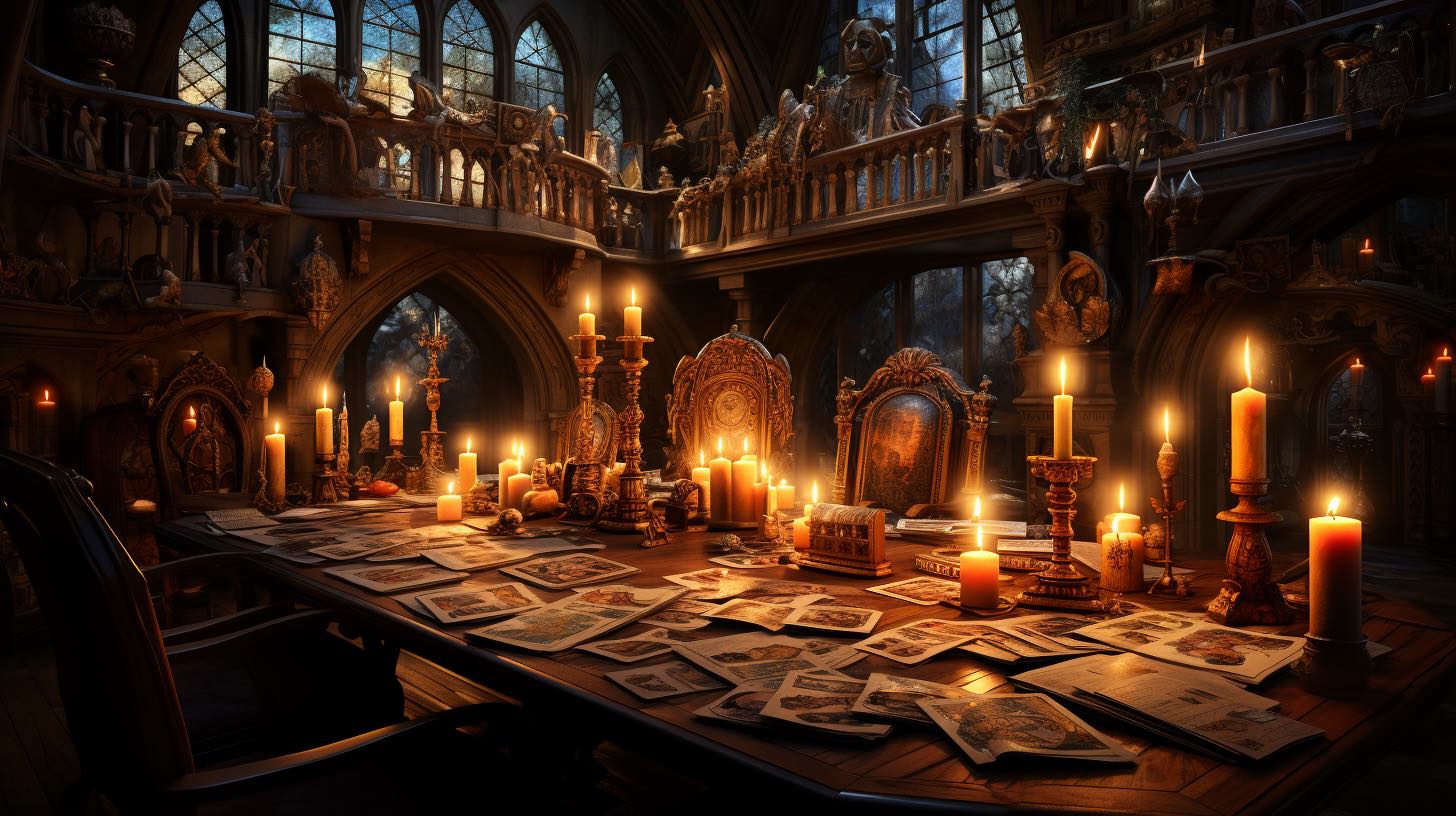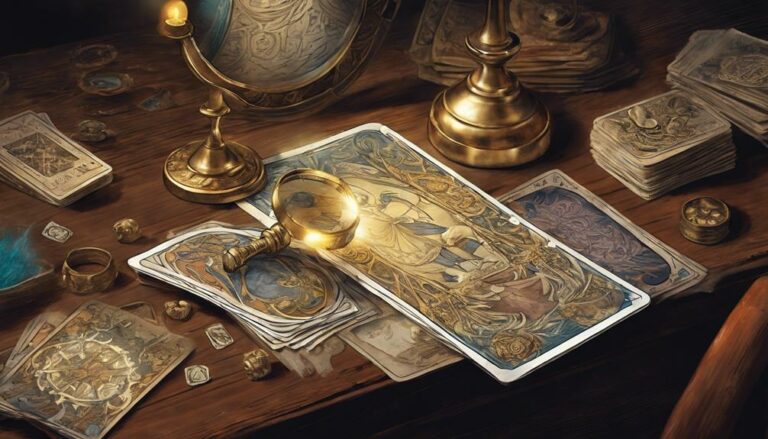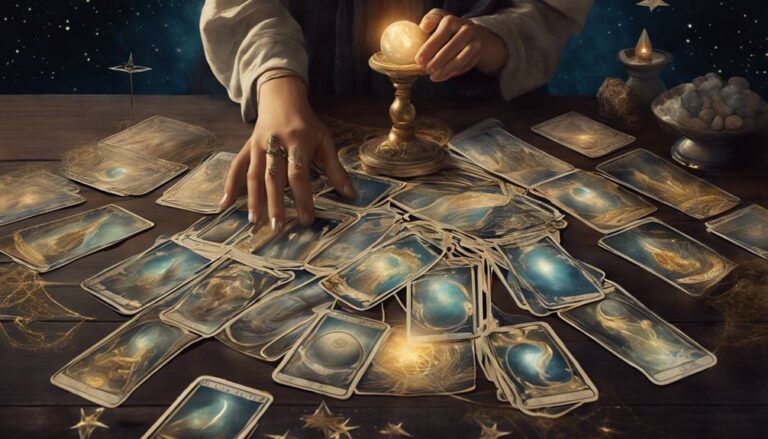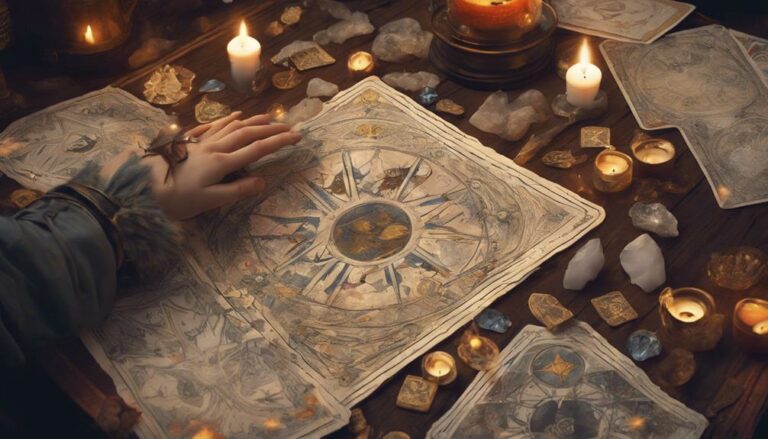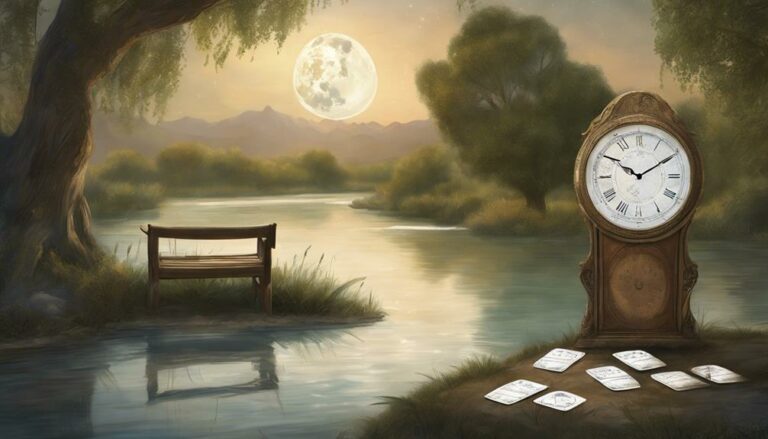Hey there, fellow seekers of wisdom and guidance! Have you ever been captivated by the enigmatic allure of tarot cards? Imagine holding in your hands not just a deck of playing cards, but a portal to ages past, a mirror to the human soul, and a guide through life’s labyrinth. As an ardent tarot enthusiast and your trusty advisor, I’m thrilled to be your companion on this journey of discovery.
Table of Contents
ToggleIntroduction
In the realm of tarot, history and mystique intertwine like the threads of fate itself. These cards, which have adorned the tables of nobles and intrigued the minds of seekers for centuries, hold secrets that span continents and epochs. We’re about to embark on a voyage that will unravel the tapestry of time, revealing how tarot cards, once mere tools for amusement, have evolved into vessels of insight and revelation.
As we navigate the historical background of tarot cards, we’ll peel back layers of ambiguity, uncovering their obscure origins, exploring the esoteric paths they’ve tread, and tracing their connection to the realms of the occult and the metaphysical. Along the way, we’ll encounter visionary individuals who breathed life into these cards, transforming them into potent instruments of divination and self-discovery.
But the journey doesn’t end there. The spotlight will shine on the iconic Rider-Waite Tarot deck, a masterpiece that redefined how we perceive these cards and their meanings. We’ll witness how tarot cards emerged from the shadows of niche practices to embrace the embrace of mainstream culture, finding their place in the vibrant tapestry of modern life.
Together, we’ll challenge skepticism and unravel misconceptions, exploring the deeper currents that underlie the practice of tarot readings. We’ll see that these cards are not simply fortune-telling tools, but mirrors reflecting the kaleidoscope of human experience, inviting us to engage with our hopes, fears, and potential paths.
So, grab your virtual seat, shuffle your curiosity, and let’s embark on a quest to unearth the historical treasures of tarot cards. Whether you’re a seasoned reader or a curious novice, this expedition promises to deepen your understanding, broaden your perspective, and perhaps even spark a lifelong fascination with the intricate world of tarot.
Are you ready to journey through time, space, and the enigmatic meanings of the cards? Let’s unravel the historical background of tarot cards together, and discover the echoes of the past that still resonate in our modern lives.
Origins of Tarot Cards
Picture yourself in the enchanting courts of 15th century Europe, where a deck of cards held more than just games – it held the seeds of an enigmatic journey. The exact origins of tarot cards are shrouded in the mists of time, like whispers carried on the wind. Some say they emerged in the bustling markets of Italy, others suggest ancient Egypt as their birthplace. Regardless of their origins, these cards began as playful companions in the courts, engaging both nobles and commoners in a game of strategy and chance.
At their inception, tarot cards weren’t steeped in mysticism or divination. They were, quite simply, a deck of playing cards, with suits akin to modern-day decks – cups, swords, coins, and wands. Imagine the vibrant scenes as players gathered around tables, placing their bets and strategizing their moves, oblivious to the metaphysical journey these cards would later embark upon.
As we delve into the origins of tarot cards, it’s important to remember that their evolution was a gradual one, much like the turning of pages in a book. These cards were vehicles of entertainment, a pastime that transcended borders and spoke a universal language. Little did they know that their symbols and archetypes would evolve into windows to the soul, reflecting the inner landscapes of those who would later seek their guidance.
While the exact timeline and birthplace remain mysteries, what’s undeniable is that tarot cards set foot on a path that led them from the world of games to the realm of mysticism. They carried secrets within their intricate designs, waiting for the right minds and hearts to unlock their deeper meanings. And so, the journey of tarot cards continued, winding its way through history, culture, and the human desire to understand the unseen forces that shape our lives.
Esoteric and Mystical Associations
Fast forward through the corridors of time, and we find ourselves in a world where tarot cards have shed their mundane origins and donned the robes of the mystical. The once-humble playing cards underwent a metamorphosis, becoming vessels for tapping into the whispers of the universe. It’s here, in the realm of esoteric and mystical associations, that the true magic of tarot cards began to unfold.
Imagine the flickering candlelight of dimly lit rooms, where seekers gathered to explore the hidden realms beyond the tangible. Tarot cards, with their enigmatic symbols and archetypes, became tools for divination – a practice that sought to bridge the gap between the material and the ethereal. As an advisor who has stood at this crossroads between the seen and the unseen, I can attest to the power these cards hold in unlocking insights that lie beyond the surface.
The journey from mere playing cards to conduits of higher wisdom was no small feat. Each card transformed into a symbol, a gateway to truths that transcended the mundane. The High Priestess stood as a sentinel of intuition, the Wheel of Fortune turned with the ebb and flow of destiny, and the Fool embarked on a journey of limitless potential. The tapestry of life, death, love, and struggle found expression in these cards, resonating with seekers as they ventured deeper into the labyrinth of their own consciousness.
In the hands of adept readers, tarot cards became a mirror that reflected the inner landscapes of those seeking guidance. They whispered stories of personal struggles and triumphs, offering a unique perspective on life’s challenges. The act of drawing cards and interpreting their meanings evolved into a sacred ritual, a dance between the reader’s intuition and the universal energies that flowed through the symbols.
As we explore the esoteric and mystical associations of tarot cards, we step into a realm where the boundaries of time and space blur. These cards have become an anchor for those seeking answers, a source of solace for the curious, and a portal to the vast expanse of the unknown. They’ve transcended their humble beginnings to become a bridge between the human spirit and the mysteries of existence – a bridge that beckons us to cross and uncover the truths that lie within and beyond.
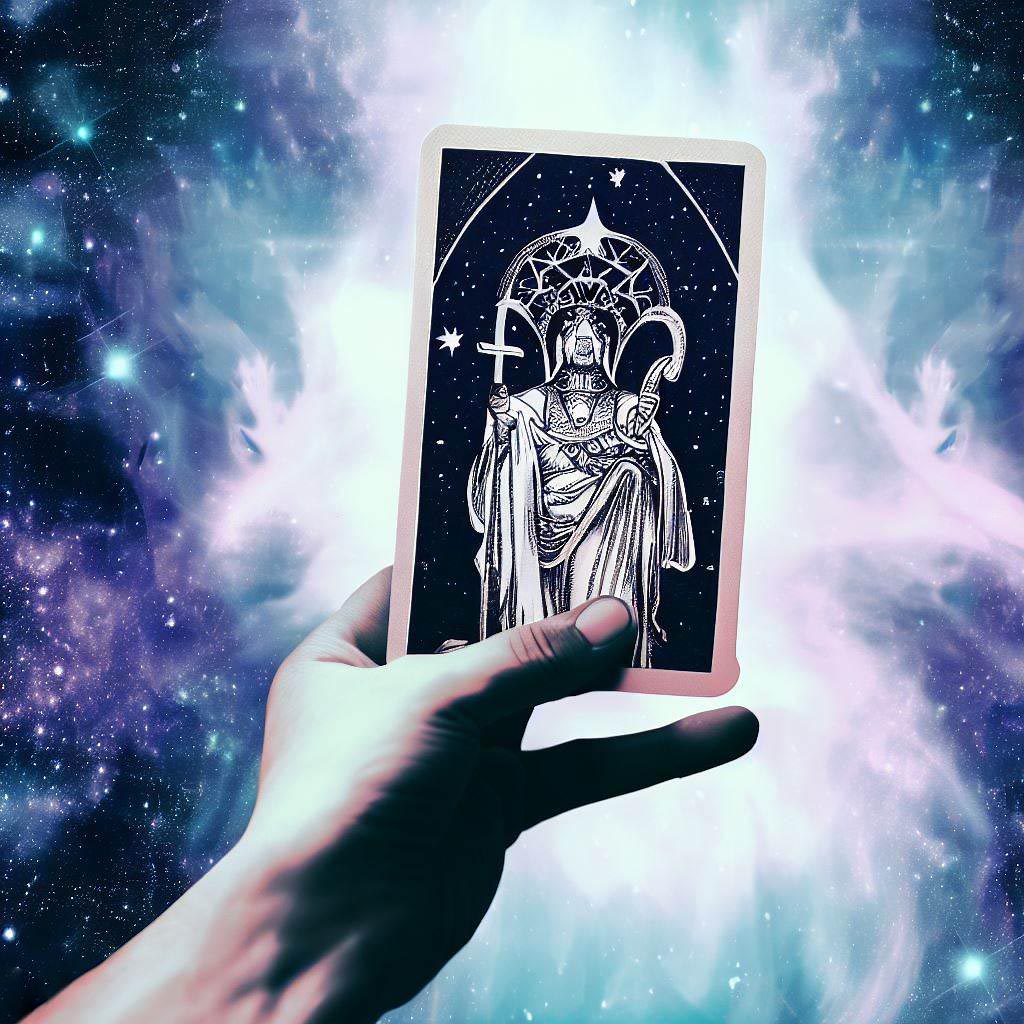
Connection to Occult and Metaphysical Movements
Step into the shadows of history, and you’ll find tarot cards weaving their enigmatic threads into the tapestry of the occult and metaphysical movements. These once-playful cards evolved from mere tools of entertainment to become conduits for tapping into the mysteries that lie beyond the surface of reality. As we venture deeper into their journey, we’ll uncover how tarot cards became inseparable companions of visionaries, seekers, and explorers of the unseen.
The 18th and 19th centuries were marked by a surge in interest in the occult and metaphysical realms. Pioneers of esoteric thought saw in tarot cards a key to unlock ancient wisdom, a visual lexicon of symbols that could decode the secrets of the universe. The connection between tarot and these burgeoning movements was solidified, and the cards found their place within the mystical societies and circles that sought to unravel the threads of reality.
Tarot cards, once symbols of earthly pleasures, transformed into gateways to the unknown. Figures like Eliphas Lévi saw in these cards a reflection of the Kabbalistic Tree of Life, a map of consciousness that held the keys to enlightenment. The cards were now more than tools; they were archetypal mirrors reflecting the collective subconscious, the cosmic dance of opposites, and the journey of the soul through the realms of existence.
The symbiotic relationship between tarot and the occult persisted, and each movement left its mark on the cards. The Major Arcana, with its potent symbols and allegories, took on new dimensions as it intertwined with the teachings of alchemy, astrology, and mysticism. These cards became windows into the human experience, mirroring the trials, triumphs, and transformations that shape our paths.
As an advisor, I’m intrigued by the convergence of these forces. Tarot cards, infused with the spirit of the occult and the metaphysical, emerged as tools not just for divination, but for introspection, transformation, and communion with higher realms. They became portals through which seekers could traverse the boundaries of the known, exploring the depths of their own consciousness and the cosmos itself.
In this dance between the visible and the hidden, the mundane and the mystical, tarot cards found their purpose – as guides for those who dared to peer beyond the veil. Their journey from palaces to secret chambers, from cards to keys of knowledge, reminds us that the story of tarot is more than history; it’s an ongoing conversation between humanity’s quest for truth and the enigmatic forces that shape our reality.
Rider-Waite Tarot Deck
Ah, the Rider-Waite Tarot deck! If tarot cards had rock stars, this deck would surely claim the spotlight. Crafted by Arthur Edward Waite and brought to life by the talented Pamela Colman Smith, this deck revolutionized tarot symbolism. Each card became a canvas of emotions, challenges, and triumphs. As I shuffle these cards for guidance, I’m reminded of the timeless wisdom they offer.

Journey to Mainstream Popularity
In the grand tapestry of tarot’s history, a fascinating chapter unfolds as these mystical cards transitioned from the realms of secrecy to the spotlight of mainstream popularity. The journey, marked by twists and turns, led tarot cards from the shadows of esoteric circles to the bustling streets of modern culture. As we embark on this segment of their odyssey, we’ll explore the captivating tale of how tarot emerged from obscurity to claim its place in the hearts and minds of people worldwide.
From whispers in dimly lit rooms to vibrant portrayals on the silver screen, tarot cards found their way into the hands of artists, writers, and creators who recognized their visual and symbolic potency. These cards became not only tools for divination but also sources of inspiration for literature, art, and even pop culture phenomena. The archetypes contained within the cards resonated with the human experience, capturing universal themes that transcended time and space.
As the 20th century dawned, tarot cards embarked on a new adventure – one that would propel them into the mainstream consciousness. This transformation owes much to the pioneering work of figures like Arthur Edward Waite and Pamela Colman Smith, whose Rider-Waite Tarot deck breathed fresh life into the cards. With intricate illustrations and rich symbolism, this deck bridged the gap between the arcane and the accessible, making tarot readings a tool for the masses.
As a tarot enthusiast, I can’t help but marvel at how these once-mysterious cards found their way into popular media. They graced the pages of novels, adorned album covers, and even made appearances in television shows and movies. Tarot cards became cultural symbols, reflecting a collective yearning for guidance, insight, and a touch of the mystical in our modern lives.
Today, it’s not uncommon to stumble upon tarot cards in the homes of friends, on social media feeds, and even in the hands of celebrities. These cards, once reserved for the select few who ventured into the esoteric, have become accessible tools for self-discovery and reflection. Their journey from the fringes of society to the heart of popular culture is a testament to their enduring relevance and the timeless truths they encapsulate.
In this age of information and interconnectedness, tarot cards stand as bridges between the ancient and the contemporary, the seen and the unseen. Their journey from obscurity to mainstream popularity is a reminder that the human spirit yearns for meaning, and these cards – with their symbols, archetypes, and mysteries – offer a unique lens through which to explore the vast landscape of existence. As we gaze upon these cards, we’re invited to partake in a journey that transcends time, inviting us to ponder our place in the grand narrative of life.
Criticism and Skepticism
As we delve deeper into the captivating realm of tarot cards, it’s essential to address the elephant in the room – the skepticism and criticism that often shroud these mystical companions. While many find solace, guidance, and inspiration in tarot readings, others raise their eyebrows and question their validity. As a dedicated tarot enthusiast and advisor, I welcome this candid discussion about the doubts that sometimes cloud the cards’ brilliance.
Skepticism, in many ways, is a natural response to the unknown. Tarot readings, with their reliance on symbols, intuition, and unseen energies, can feel like a leap of faith into uncharted territories. Some skeptics dismiss these readings as mere fortune-telling, believing that the cards offer vague, one-size-fits-all answers that hold little substance. They question whether a deck of cards could truly hold insights into life’s complexities.
Critics also highlight the risk of self-fulfilling prophecies. They argue that when seekers receive a tarot reading, they might subconsciously shape their decisions and actions to align with the cards’ predictions, thus altering the course of events. In essence, they worry that tarot readings might lead individuals down paths they wouldn’t have chosen otherwise, based solely on the interpretation of symbols.
Furthermore, some critics voice concerns about the lack of scientific evidence supporting the accuracy of tarot readings. In a world driven by data and empirical validation, the intuitive nature of tarot can feel at odds with established methodologies. They challenge the notion that a deck of cards can provide genuine insights into the future or offer meaningful guidance for life’s challenges.
As someone who cherishes the art of tarot reading, I acknowledge these concerns and welcome the opportunity to engage in open dialogue. It’s crucial to recognize that tarot cards are not crystal balls; they’re tools that facilitate self-reflection, intuition, and introspection. A skilled reader does not claim to predict the future with certainty but rather acts as a guide, helping seekers navigate their inner landscapes and consider different perspectives.
Moreover, the beauty of tarot lies in its subjectivity. Each reading is a unique experience, a dance between the symbols on the cards and the intuitive interpretation of the reader. While some might find profound meaning in a reading, others may view it as a source of contemplation rather than a definitive roadmap.
In the end, the world of tarot cards is a tapestry woven from threads of belief, skepticism, curiosity, and exploration. It’s a realm where individual experiences and interpretations intertwine to create a mosaic of understanding. As we continue our journey through the historical background of tarot cards, let’s embrace the diversity of perspectives, acknowledging that the enigmatic nature of these cards invites us to contemplate the unknown, question our assumptions, and explore the intricate interplay between symbols and the human psyche.
Conclusion
And so, our journey through the historical background of tarot cards comes to a close – a journey that has taken us from the palaces of the past to the bustling streets of today, from playing cards to portals of insight, and from skepticism to a dance with the mystical. As a devoted tarot enthusiast and advisor, it’s my privilege to have walked alongside you, shedding light on the diverse facets of these captivating cards.
From their uncertain origins as games of chance in 15th century Europe, tarot cards have traversed time, culture, and consciousness. They evolved from mere entertainment to tools of divination, reflecting the evolving needs and aspirations of humanity. The esoteric and mystical associations breathed life into the symbols, connecting us with ancient wisdom and unseen energies that shape our existence.
As tarot cards intertwined with the currents of the occult and metaphysical movements, they became bridges to higher truths, guiding seekers on inner quests and cosmic explorations. The journey to mainstream popularity saw them shedding the veils of obscurity, stepping into the limelight of modern culture as vessels of inspiration, introspection, and personal growth.
Yet, this journey hasn’t been without its critics and skeptics. The very nature of tarot readings, reliant on intuition and symbols, has invited doubt and questioning. We’ve explored the concerns raised about the accuracy, validity, and scientific foundation of tarot cards, recognizing that the realm of the unknown can be met with hesitation.
But just as the cards themselves are a mosaic of symbols, meanings, and interpretations, so too is the tapestry of human experience. Tarot cards, with their rich history and enigmatic allure, invite us to embrace the complexities of life – the known and the unknown, the mundane and the mystical. They beckon us to seek guidance, ponder our choices, and cultivate a deeper understanding of ourselves and the world around us.
As I place the cards back into their deck, I’m reminded that the journey of tarot mirrors our own – a journey of discovery, growth, and transformation. From the past to the present, from the material to the spiritual, tarot cards illuminate the path we tread, offering glimpses into the profound and the profound within us. So, whether you’re a seeker, a skeptic, or simply curious, remember that the historical background of tarot cards is an ever-unfolding narrative, inviting us to explore, reflect, and evolve.
Thank you for embarking on this journey with me. As you carry the wisdom of tarot with you, may it serve as a guiding light, igniting your curiosity, nurturing your introspection, and inspiring your connection with the mysteries of life.
Frequently Asked Questions
Are tarot cards only used for fortune-telling?
Tarot cards have evolved beyond fortune-telling. They now serve as tools for self-reflection, personal growth, and gaining insights into life’s complexities.
Can anyone learn to read tarot cards?
Absolutely! While it requires practice and patience, anyone with an open mind can learn to read tarot cards. It’s about connecting with the symbolism and trusting your intuition.
What makes the Rider-Waite Tarot deck special?
The Rider-Waite Tarot deck introduced rich symbolism and imagery, making it accessible and meaningful. Its influence shaped modern tarot interpretation.
Do tarot cards have religious connections?
Tarot cards themselves aren’t tied to any specific religion. However, they can be used within spiritual and personal belief systems for guidance and insight.
How do skeptics view tarot readings?
Skeptics often view tarot readings with suspicion due to their mystical associations. However, many have found value in the introspective and psychological aspects of tarot.

